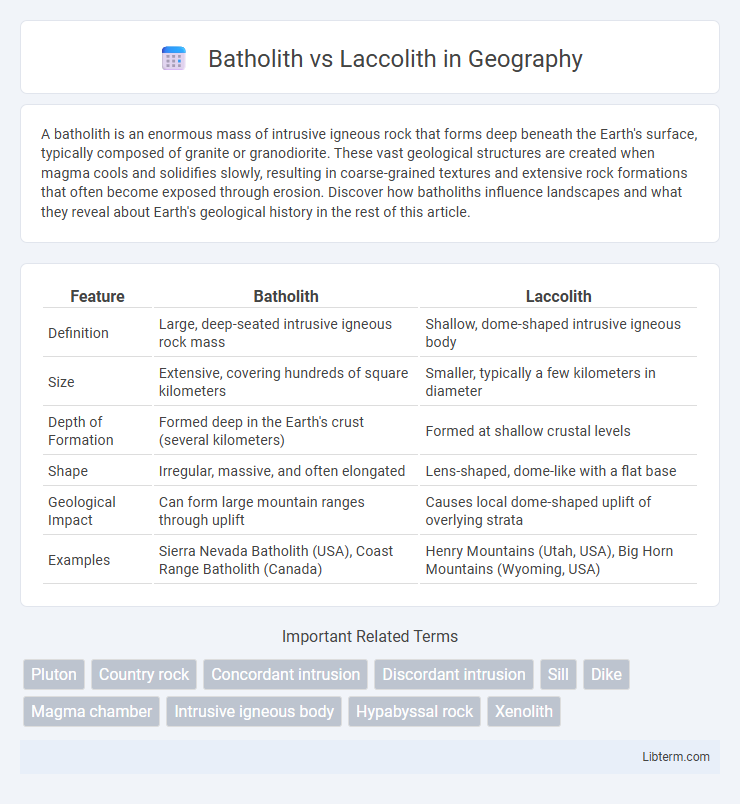A batholith is an enormous mass of intrusive igneous rock that forms deep beneath the Earth's surface, typically composed of granite or granodiorite. These vast geological structures are created when magma cools and solidifies slowly, resulting in coarse-grained textures and extensive rock formations that often become exposed through erosion. Discover how batholiths influence landscapes and what they reveal about Earth's geological history in the rest of this article.
Table of Comparison
| Feature | Batholith | Laccolith |
|---|---|---|
| Definition | Large, deep-seated intrusive igneous rock mass | Shallow, dome-shaped intrusive igneous body |
| Size | Extensive, covering hundreds of square kilometers | Smaller, typically a few kilometers in diameter |
| Depth of Formation | Formed deep in the Earth's crust (several kilometers) | Formed at shallow crustal levels |
| Shape | Irregular, massive, and often elongated | Lens-shaped, dome-like with a flat base |
| Geological Impact | Can form large mountain ranges through uplift | Causes local dome-shaped uplift of overlying strata |
| Examples | Sierra Nevada Batholith (USA), Coast Range Batholith (Canada) | Henry Mountains (Utah, USA), Big Horn Mountains (Wyoming, USA) |
Introduction to Batholiths and Laccoliths
Batholiths are massive, deep-seated igneous rock bodies formed from cooled magma chambers, typically covering areas greater than 100 square kilometers and often composing the core of mountain ranges. Laccoliths are smaller, dome-shaped intrusions that uplift overlying strata, created when viscous magma intrudes between layers of sedimentary rock without reaching the surface. Both batholiths and laccoliths represent intrusive igneous formations but differ in size, shape, and their impact on surrounding geological structures.
Defining Batholiths: Characteristics and Formation
Batholiths are massive, intrusive igneous rock bodies that form deep within the Earth's crust through the slow cooling and solidification of magma, often extending over 100 square kilometers. Characterized by coarse-grained textures and composed predominantly of granitic minerals, batholiths provide evidence of prolonged geological processes and crustal evolution. Their formation involves the coalescence of multiple magma chambers, resulting in large, irregularly shaped plutons that underpin major mountain ranges.
Understanding Laccoliths: Structure and Development
Laccoliths are dome-shaped igneous intrusions that form when viscous magma intrudes between layers of sedimentary rock, causing the overlying strata to bulge upward. Their structure is characterized by a flat base with a convex upper surface, typically smaller and more localized than batholiths, which are extensive, deep-seated intrusive bodies. The development of laccoliths involves magma ascending through existing rock fractures, cooling, and solidifying, which leads to distinctive geological formations often observable in mountainous regions.
Key Differences Between Batholiths and Laccoliths
Batholiths are massive, irregularly shaped intrusive igneous rock bodies that cover more than 100 square kilometers, whereas laccoliths are smaller, lens-shaped intrusions formed when magma intrudes between sedimentary layers, causing uplift. Batholiths typically form deep underground and are exposed only after extensive erosion, while laccoliths are found at shallower depths and create dome-like structures on the surface. The scale, shape, depth of formation, and associated surface deformation are the key distinguishing factors between batholiths and laccoliths.
Geological Processes Behind Batholith Formation
Batholiths form from the slow cooling and solidification of large magma bodies deep within the Earth's crust, typically associated with subduction zones where oceanic plates melt and generate magma. These massive intrusive igneous rock bodies can cover hundreds of square kilometers and are composed predominantly of coarse-grained granite or granodiorite. The geological process involves magma rising gradually, crystallizing slowly under high pressure, which creates the extensive, hardened rock masses characteristic of batholiths, contrasting with the smaller, dome-shaped laccoliths formed by shallow magma intrusions lifting overlying strata.
Mechanisms of Laccolith Emplacement
Laccolith emplacement occurs when viscous magma intrudes between sedimentary layers, causing the overlying strata to dome upward due to pressure. Unlike batholiths, which form deep underground through large magma chambers cooling slowly, laccoliths typically develop closer to the Earth's surface, resulting in smaller, lens-shaped igneous bodies. The mechanical process involves magma injection forcing rock layers to arch without extensive fracturing, creating distinctive uplifted formations characteristic of laccoliths.
Batholiths in Famous Geological Landscapes
Batholiths are massive igneous rock formations that form deep beneath the Earth's surface and are exposed over time through erosion, making them prominent features in famous geological landscapes such as the Sierra Nevada in California and the Coastal Mountains of British Columbia. These colossal structures consist mainly of granite and cover hundreds to thousands of square kilometers, representing the fused magma chambers of ancient volcanoes. Unlike laccoliths, which are smaller, dome-shaped intrusions causing localized uplift, batholiths dictate large-scale mountain building and regional geological architecture.
Notable Examples of Laccoliths Around the World
Notable examples of laccoliths include the Henry Mountains in Utah, USA, characterized by their dome-shaped intrusions formed by magma pushing sedimentary layers upward. The Pine Valley Laccolith in Utah is one of the largest and most studied laccoliths, showcasing classic features of these intrusive igneous bodies. In India, the Deccan Traps region hosts several laccolithic structures, illustrating the global distribution and geological significance of laccolith formations.
Batholiths vs Laccoliths: Geological Significance
Batholiths, massive igneous intrusions often exceeding 100 square kilometers, shape continental crust and reveal tectonic processes from deep Earth melting. Laccoliths, smaller lens-shaped intrusions, uplift overlying strata creating distinct domes and serve as markers of localized magma emplacement. The geological significance lies in Batholiths' role in continental growth and mountain formation, while Laccoliths illustrate shallow magma dynamics and influence surface topography.
Summary: Comparing Batholith and Laccolith Formations
Batholiths are massive, intrusive igneous rock bodies that form deep underground over millions of years, often covering hundreds of square kilometers, while laccoliths are smaller, dome-shaped intrusions that cause the overlying strata to arch upward. Batholiths typically form the cores of mountain ranges and are composed mainly of granite, whereas laccoliths consist of more viscous magma, such as rhyolite or diorite, that intrudes between sedimentary layers. Both formations result from magma intrusion but differ significantly in size, shape, and the structural impact on surrounding rock layers.
Batholith Infographic

 libterm.com
libterm.com